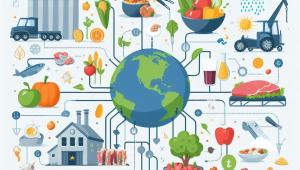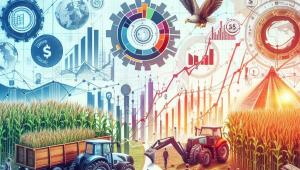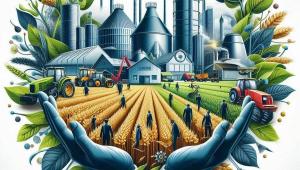Education is a critical component of agricultural development, as it enables farmers, researchers, and other stakeholders to acquire the knowledge, skills, and attitudes needed to improve agricultural productivity, sustainability, and resilience. Educational resources, such as curricula, training materials, and learning tools, play a crucial role in facilitating and enhancing agricultural education, and in supporting lifelong learning and innovation in the agricultural sector.
Types of Educational Resources in Agriculture
Educational resources in agriculture can take many forms and serve different purposes, depending on the target audience, the learning objectives, and the delivery mode. Some of the main types of educational resources in agriculture include:
Textbooks and Manuals
Textbooks and manuals are one of the most traditional and widely used types of educational resources in agriculture. They provide a structured and comprehensive overview of a particular subject or topic and are often used as the primary learning material in formal education settings, such as universities and vocational schools.
Agricultural textbooks and manuals cover a wide range of subjects, from basic sciences, such as biology, chemistry, and physics, to applied disciplines, such as agronomy, animal science, and agricultural economics. They are typically written by experts in the field and are regularly updated to reflect the latest research and developments.
Some examples of agricultural textbooks and manuals include:
- "Introduction to Agronomy: Food, Crops, and Environment" by Craig C. Sheaffer and Kristine M. Moncada
- "Animal Science: A Comprehensive Approach" by John R. Campbell and M. Douglas Kenealy
- "Agricultural Economics" by H. Evan Drummond and John W. Goodwin
While textbooks and manuals are valuable resources for providing a solid foundation in agricultural knowledge, they also have limitations, such as their high cost, their limited interactivity and adaptability, and their potential for becoming outdated quickly in a rapidly changing field.
Extension Materials and Fact Sheets
Extension materials and fact sheets are educational resources that are specifically designed for farmers, rural communities, and other non-academic audiences. They provide practical and actionable information on a specific topic or problem and are often delivered through extension services, farmer organizations, and other outreach channels.
Extension materials and fact sheets are usually shorter and more focused than textbooks and manuals, and use a more accessible and engaging language and format, such as illustrations, diagrams, and case studies. They are also more adaptable to local contexts and needs and can be easily translated and disseminated in different languages and media.
Some examples of extension materials and fact sheets include:
- "Soil Fertility Management for Organic Crops" by Mark Schonbeck, Virginia Association for Biological Farming
- "Integrated Pest Management for Tomatoes" by Mary Louise Flint, University of California Agriculture and Natural Resources
- "Beekeeping for Beginners" by Keith S. Delaplane, University of Georgia Cooperative Extension
Extension materials and fact sheets are important resources for bridging the gap between research and practice, and for empowering farmers and rural communities with knowledge and skills for sustainable agriculture. However, they also face challenges, such as the need for regular updating and quality control, the limited reach and accessibility of some extension channels, and the potential for conflicting or inconsistent information from different sources.
Online Courses and Learning Platforms
Online courses and learning platforms are educational resources that leverage digital technologies and the internet to deliver agricultural education and training remotely and at scale. They provide a flexible and interactive learning experience that can be accessed anytime, anywhere, and at the learner's own pace.
Online courses and learning platforms in agriculture cover a wide range of topics and levels, from introductory courses for beginners to advanced courses for professionals. They use various formats and tools, such as videos, quizzes, discussion forums, and virtual labs, to engage learners and facilitate knowledge acquisition and application.
Some examples of online courses and learning platforms in agriculture include:
- "Sustainable Agricultural Land Management" by the World Bank Group on Coursera
- "Agriculture, Economics and Nature" by the University of Western Australia on edX
- "Organic Farming for Sustainable Agricultural Production" by the Indian Institute of Technology Kharagpur on NPTEL
Online courses and learning platforms offer many benefits for agricultural education, such as increased access and flexibility, reduced costs and travel, and the ability to reach a global audience. However, they also face challenges, such as the digital divide and the need for reliable internet connectivity, the limited hands-on and practical experience, and the potential for low completion rates and engagement.
Videos and Multimedia
Videos and multimedia are educational resources that use visual and audio elements to convey information and demonstrate agriculture practices. They are often used as supplementary or stand-alone learning materials and can be accessed through various channels, such as social media, websites, and mobile apps.
Agricultural videos and multimedia cover a wide range of topics and styles, from instructional videos on specific techniques and technologies to documentary films on agricultural issues and innovations. They can be produced by various actors, such as extension services, research institutions, NGOs, and farmers themselves.
Some examples of agricultural videos and multimedia include:
- "Drip Irrigation for Small Farms" by the International Fund for Agricultural Development (IFAD) on YouTube
- "The Sustainable Farming Podcast" by the Sustainable Farming Association on multiple podcast platforms
- "The Crop Trust Interactive Map of Crop Diversity" by the Crop Trust on their website
Videos and multimedia are powerful tools for agricultural education, as they can illustrate complex concepts and processes, showcase real-world examples and experiences, evoke emotions, and inspire action. However, they also have limitations, such as the high production costs and skills required, the potential for misinformation and bias, and the limited interactivity and feedback.
Mobile Apps and Decision Support Tools
Mobile apps and decision support tools are educational resources that provide targeted and timely information and advice to farmers and other agricultural stakeholders, based on data and algorithms. They leverage the ubiquity and functionality of mobile devices, such as smartphones and tablets, to deliver personalized and context-specific recommendations and alerts.
Agricultural mobile apps and decision support tools cover a wide range of functions and domains, from weather forecasting and market information to pest and disease diagnosis and management. They often integrate various data sources and models, such as remote sensing, soil testing, and crop modeling, to generate actionable insights and decisions.
Some examples of agricultural mobile apps and decision support tools include:
- "Plantix" by PEAT, an app that uses image recognition to diagnose plant diseases and nutrient deficiencies
- "FarmERP" by Shivrai Technologies, a farm management software that helps farmers plan, monitor, and analyze their operations
- "Agrible" by Nutrien Ag Solutions, a platform that provides field-level insights and recommendations for precision agriculture
Mobile apps and decision support tools are promising resources for agricultural education, as they can provide real-time and relevant information and support to farmers, even in remote and low-resource settings. However, they also face challenges, such as the need for accurate and reliable data and models, the potential for data privacy and security issues, and the limited adoption and digital literacy among some user groups.
Formats and Delivery Modes of Educational Resources
Educational resources in agriculture can be designed and delivered in various formats and modes, depending on the learning objectives, the target audience, and the available technologies and resources. The choice of format and delivery mode can influence the effectiveness, accessibility, and scalability of the educational resource, and should be aligned with the needs and preferences of the learners and educators.
Some of the main formats and delivery modes of educational resources in agriculture include:
Print-Based Resources
Print-based resources, such as textbooks, manuals, and fact sheets, are some of the most traditional and widely used formats of educational resources in agriculture. They provide a tangible and permanent record of the learning material and can be easily distributed and used in various settings, such as classrooms, libraries, and homes.
Print-based resources have several advantages, such as their durability, portability, and familiarity for many learners and educators. They also have some limitations, such as their high production and distribution costs, their limited interactivity and updatability, and their environmental impact in terms of paper and ink use.
To enhance the effectiveness and accessibility of print-based resources, they can be designed with features such as:
- Clear and concise writing, with simple and engaging language and examples
- Visual aids, such as images, charts, and diagrams, to illustrate key concepts and processes
- Structured and modular content, with clear learning objectives and summaries for each section
- Cross-references and links to other resources, such as websites and videos, for further learning
- Translation and localization for different languages and cultural contexts
Digital Resources
Digital resources, such as e-books, websites, and mobile apps, are increasingly used as formats of educational resources in agriculture, due to their flexibility, interactivity, and accessibility. They can be easily updated and shared and can incorporate various media and features, such as videos, animations, quizzes, and forums, to engage learners and facilitate learning.
Digital resources have several advantages, such as their low marginal costs, their ability to reach a wide and diverse audience, and their potential for personalization and adaptation to individual learning needs and preferences. They also have some limitations, such as the need for digital devices and internet connectivity, the potential for digital divides and exclusion, and the challenges of quality assurance and intellectual property rights.
To enhance the effectiveness and accessibility of digital resources, they can be designed with features such as:
- Responsive and user-friendly interfaces, with clear navigation and search functions
- Multimedia and interactive elements, such as videos, simulations, and games, to demonstrate and reinforce learning
- Social and collaborative tools, such as discussion forums and peer review, facilitate knowledge sharing and co-creation
- Adaptive and personalized learning paths, based on learner preferences and performance data
- Open and interoperable formats, such as HTML and SCORM, to enable reuse and integration with other systems
Blended Learning
Blended learning is a delivery mode that combines face-to-face and online learning activities and resources, to leverage the strengths and mitigate the weaknesses of each format. It can take various forms, such as flipped classrooms, where learners access online resources before class and engage in active learning during class, or hybrid courses, where some sessions are conducted online and others are conducted in person.
Blended learning has several advantages, such as increased flexibility and convenience for learners, enhanced interaction and engagement between learners and educators, and the ability to accommodate different learning styles and preferences. It also has some limitations, such as the need for careful design and coordination of the different components, the potential for increased workload and complexity for educators, and the challenges of ensuring equity and inclusion for all learners.
To enhance the effectiveness and accessibility of blended learning, it can be designed with features such as:
- Clear and consistent communication and expectations for learners and educators
- Balanced and complimentary use of face-to-face and online activities and resources
- Active and collaborative learning strategies, such as problem-based learning and peer feedback
- Formative and summative assessments, to monitor and support learner progress and achievement
- Flexible and inclusive support services, such as technical support and accommodations for learners with disabilities
Distance and Online Learning
Distance and online learning are delivery modes that provide educational resources and activities entirely through remote and digital means, without the need for physical presence or interaction. They can take various forms, such as self-paced courses, where learners access and complete the resources on their schedule, or synchronous courses, where learners participate in live online sessions with educators and peers.
Distance and online learning have several advantages, such as increased access and flexibility for learners, particularly those in remote or underserved areas, the ability to scale up and reach a large and diverse audience, and the potential for cost-effectiveness and resource efficiency. They also have some limitations, such as the need for reliable and affordable internet connectivity and devices, the potential for isolation and disengagement of learners, and the challenges of ensuring the quality and credibility of the learning experience and outcomes.
To enhance the effectiveness and accessibility of distance and online learning, it can be designed with features such as:
- Clear and structured learning objectives and activities, with regular milestones and feedback
- Engaging and interactive multimedia resources, such as videos, podcasts, and simulations
- Collaborative and social learning opportunities, such as group projects and online communities
- Personalized and adaptive learning paths, based on learner goals, preferences, and performance
- Comprehensive and proactive support services, such as online tutoring, mentoring, and career guidance
Applications and Benefits of Educational Resources in Agriculture
Educational resources in agriculture have various applications and benefits, depending on the specific context and goals of the learners and educators. Some of the main applications and benefits of educational resources in agriculture include:
Formal Education and Training
Educational resources are essential components of formal education and training programs in agriculture, such as degree programs, vocational courses, and professional development workshops. They provide the foundational knowledge and skills that learners need to succeed in their academic and career pursuits and to contribute to the advancement of the agricultural sector.
Formal education and training in agriculture can have several benefits, such as:
- Developing a skilled and knowledgeable workforce for the agricultural sector, with the capacity to innovate and adapt to changing conditions and challenges
- Enhancing the productivity, sustainability, and resilience of agricultural systems, by applying evidence-based practices and technologies
- Promoting social and economic development in rural communities, by creating employment and entrepreneurship opportunities in the agricultural value chain
- Advancing scientific research and discovery in agriculture, by training the next generation of researchers and experts
To maximize the benefits of formal education and training in agriculture, educational resources should be:
- Aligned with the needs and priorities of the agricultural sector and the labor market, as identified through stakeholder engagement and workforce analysis
- Designed and delivered with input and participation from agricultural experts, practitioners, and employers, to ensure relevance and applicability
- Regularly updated and improved based on feedback and evaluation data, to maintain quality and effectiveness
- Accessible and affordable for diverse learners, including those from disadvantaged and underrepresented groups, through scholarships, loans, and other support mechanisms
Extension and Outreach
Educational resources are also widely used in extension and outreach programs in agriculture, which aim to disseminate knowledge and technologies to farmers, rural communities, and other stakeholders, and to facilitate their adoption and application. Extension and outreach programs can take various forms, such as farmer field schools, demonstration plots, and mobile apps, and can be delivered by various actors, such as government agencies, universities, NGOs, and private companies.
Extension and outreach in agriculture can have several benefits, such as:
- Empowering farmers and rural communities with knowledge and skills to improve their livelihoods and well-being, and to adapt to changing conditions and challenges
- Facilitating the transfer and adoption of new technologies and practices, such as improved seeds, integrated pest management, and precision agriculture, to increase agricultural productivity and sustainability
- Promoting social learning and collective action among farmers and other stakeholders, to address common problems and opportunities, such as natural resource management, market access, and policy advocacy
- Bridging the gap between research and practice, by translating scientific findings into actionable recommendations and solutions for farmers and other end-users
To maximize the benefits of extension and outreach in agriculture, educational resources should be:
- Tailored to the needs, interests, and capacities of the target audience, based on participatory needs assessment and stakeholder engagement
- Designed and delivered in accessible and engaging formats and languages, such as videos, radio programs, and local dialects, to ensure understanding and relevance
- Complemented with other services and support, such as input supply, credit, and market linkages, to enable the adoption and application of the knowledge and technologies
- Monitored and evaluated for their effectiveness and impact, using both quantitative and qualitative methods, to inform continuous improvement and learning
Lifelong Learning and Innovation
Educational resources can also support lifelong learning and innovation in agriculture, by providing opportunities for continuous knowledge acquisition and skill development, and by fostering a culture of inquiry, experimentation, and creativity. Lifelong learning and innovation are essential for agricultural professionals and practitioners to keep up with the rapid pace of change and uncertainty in the agricultural sector, and to contribute to the generation and application of new ideas and solutions.
Lifelong learning and innovation in agriculture can have several benefits, such as:
- Enhancing the adaptability and resilience of agricultural professionals and practitioners, by equipping them with the knowledge and skills to anticipate and respond to new challenges and opportunities
- Promoting the generation and diffusion of new knowledge and technologies, by encouraging collaboration and exchange among diverse actors and sectors, such as farmers, researchers, entrepreneurs, and policymakers
- Strengthening the agricultural innovation system, by creating an enabling environment for research, development, and commercialization of new products and services
- Driving the transformation and sustainability of the agricultural sector, by fostering a culture of learning, experimentation, and continuous improvement
To maximize the benefits of lifelong learning and innovation in agriculture, educational resources should be:
- Diverse and flexible, to accommodate different learning styles, preferences, and contexts, and to enable self-directed and personalized learning
- Connected and networked, to facilitate the exchange and co-creation of knowledge and ideas among diverse actors and communities, and to leverage collective intelligence
- Open and accessible, to ensure the widest possible dissemination and use of knowledge and resources, and to promote transparency and accountability
- Supported by policies and institutions that value and incentivize learning and innovation, such as research funding, intellectual property rights, and recognition and reward systems
Challenges and Opportunities for Educational Resources in Agriculture
While educational resources in agriculture have many applications and benefits, they also face several challenges and opportunities, which need to be addressed to maximize their impact and sustainability.
Some of the main challenges and opportunities for educational resources in agriculture include:
Accessibility and Equity
One of the main challenges for educational resources in agriculture is ensuring their accessibility and equity, particularly for learners and educators in low-income and marginalized communities, who may face various barriers to access and use, such as:
- Limited access to technology and infrastructure, such as computers, internet, and electricity, which can hinder the use of digital and online resources
- Limited literacy and language skills, which can hinder the understanding and use of complex and technical resources, particularly those in foreign languages
- Limited financial resources, which can hinder the affordability and availability of educational resources, particularly those that require purchase or subscription
- Limited social and cultural capital, which can hinder the awareness, motivation, and support for learning and education, particularly in communities with low educational attainment and aspirations
To address these challenges and promote accessibility and equity, educational resources in agriculture should be:
- Designed and delivered in multiple formats and modalities, such as print, radio, and mobile, to reach learners with different access and preferences
- Adapted and localized to the language, culture, and context of the target audience, to ensure relevance and understanding
- Provided for free or at low cost, through open educational resources, scholarships, and other support mechanisms, to ensure affordability and availability
- Promoted and supported through community engagement, social mobilization, and partnerships with local organizations and leaders, to build awareness, motivation, and support for learning and education
Quality and Relevance
Another challenge for educational resources in agriculture is ensuring their quality and relevance, particularly in a rapidly changing and diverse sector, where knowledge and skills can quickly become outdated or irrelevant. Quality and relevance are essential for educational resources to effectively support learning and application, and to contribute to the advancement of the agricultural sector.
To ensure quality and relevance, educational resources in agriculture should be:
- Developed and reviewed by experts and practitioners in the field, to ensure accuracy, currency, and credibility of the content and pedagogy
- Aligned with the needs and priorities of the agricultural sector and the target audience, as identified through needs assessment, market analysis, and stakeholder engagement
- Designed and delivered using evidence-based and learner-centered approaches, such as active learning, problem-based learning, and experiential learning, to promote engagement, retention, and application of knowledge and skills
- Regularly updated and improved based on feedback and evaluation data, to maintain relevance and effectiveness, and to incorporate new knowledge and technologies
Collaboration and Partnership
Educational resources in agriculture are often developed and delivered by various actors and organizations, such as universities, government agencies, NGOs, and private companies, with different mandates, capacities, and resources. Collaboration and partnership among these actors are essential for leveraging their complementary strengths and expertise, avoiding duplication and fragmentation, and ensuring the sustainability and scalability of educational resources.
Collaboration and partnership in the development and delivery of educational resources in agriculture can take various forms, such as:
- Co-creation and co-ownership of educational resources, where different actors jointly develop and share the resources, based on their respective knowledge, skills, and resources
- Licensing and sharing of educational resources, where actors make their resources available to others under open or permissive licenses, such as Creative Commons, to enable reuse, adaptation, and distribution
- Networking and coordination of educational resources, where actors participate in communities of practice, platforms, and other mechanisms to share information, experiences, and resources, and to coordinate their activities and initiatives
- Capacity building and support for educational resources, where actors provide training, mentoring, and other support services to help others develop and deliver high-quality and relevant educational resources
To promote collaboration and partnership in the development and delivery of educational resources in agriculture, there is a need for:
- Policies and incentives that recognize and reward collaboration and sharing of educational resources, such as funding, recognition, and career advancement opportunities
- Platforms and tools that facilitate the discovery, access, and use of educational resources across different actors and organizations, such as repositories, search engines, and standards
- Capacity building and support services that enable actors to effectively collaborate and share educational resources, such as training, guidelines, and helpdesks
- Trust and mutual understanding among actors, based on shared values, goals, and expectations, and transparent and accountable communication and decision-making processes
Impact and Sustainability
Finally, a key challenge and opportunity for educational resources in agriculture is demonstrating and enhancing their impact and sustainability, both in terms of their effectiveness in supporting learning and application, and their long-term viability and scalability. Impact and sustainability are essential for justifying the investments and efforts in developing and delivering educational resources, and for ensuring their continued relevance and usefulness.
To demonstrate and enhance the impact and sustainability of educational resources in agriculture, there is a need for:
- Monitoring and evaluation systems that collect and analyze data on the use, outcomes, and impacts of educational resources, using both quantitative and qualitative methods, and involving different stakeholders and beneficiaries
- Feedback and improvement processes that use the monitoring and evaluation data to inform the continuous updating and enhancement of educational resources, based on the changing needs and contexts of the learners and the sector
- Business models and financing mechanisms that ensure the long-term viability and scalability of educational resources, such as revenue generation, cost recovery, and partnerships with public and private funders and investors
- Capacity building and institutionalization processes that embed the development and delivery of educational resources in the core functions and structures of organizations and systems, rather than as ad-hoc or project-based activities
Conclusion
Educational resources are essential for supporting learning, innovation, and transformation in agriculture, by providing the knowledge, skills, and tools that learners and educators need to address the complex and dynamic challenges and opportunities of the sector.
Educational resources in agriculture can take various forms and formats, such as textbooks, e-learning courses, videos, and mobile apps, and can be delivered through different modes and channels, such as classroom instruction, online learning, and extension and outreach programs.
To maximize the impact and sustainability of educational resources in agriculture, it is important to address the various challenges and opportunities related to their accessibility, equity, quality, relevance, collaboration, and sustainability. This requires a systemic and participatory approach that engages diverse stakeholders and beneficiaries, leverages diverse knowledge and resources, and adapts to the changing needs and contexts of the learners and the sector.
Some key recommendations for enhancing the impact and sustainability of educational resources in agriculture include:
- Designing and delivering educational resources in multiple formats and modalities, to ensure accessibility and equity for diverse learners and educators, particularly those in low-income and marginalized communities.
- Ensuring the quality and relevance of educational resources, by aligning them with the needs and priorities of the sector and the learners, and by using evidence-based and learner-centered approaches in their development and delivery.
- Promoting collaboration and partnership among diverse actors and organizations in the development and delivery of educational resources, by creating enabling policies, platforms, and capacities for sharing and coordination.
- Demonstrating and enhancing the impact and sustainability of educational resources, by establishing monitoring and evaluation systems, feedback and improvement processes, business models and financing mechanisms, and capacity building and institutionalization processes.
By addressing these challenges and opportunities, educational resources in agriculture can play a vital role in driving the transformation and sustainability of the sector, and in empowering learners and educators to become agents of change and innovation. This requires a long-term and systemic approach that values and invests in education and learning as key drivers of agricultural and rural development, and that fosters a culture of lifelong learning, collaboration, and innovation in the sector.
Ultimately, the goal of educational resources in agriculture is to contribute to the creation of a more knowledgeable, skilled, and innovative agricultural workforce and citizenry, that can effectively and sustainably address the global challenges of food security, poverty reduction, environmental conservation, and social justice. This is a shared responsibility and opportunity for all stakeholders in the agricultural sector, from farmers and educators to policymakers and investors, to work together towards a common vision and agenda for agricultural education and learning.










